 “Nothing should be called good that fails to enlarge our humanity.”
“Nothing should be called good that fails to enlarge our humanity.”
Marcus Aurelius. Meditations. Twelve hundred years ago.
Too bad more companies aren’t living that philosophy.
Especially now.
As technology accelerates to shocking velocities.
As competition saturates to near-commoditized levels.
As customers and employees become more isolated and disengaged.
NOBODY CAN ARGUE: Being human is good for business.
People demand it.
Customers expect it.
Employees deserve it.
And trust can’t exist without it.
THE PROBLEM IS: Not unlike caring, you can’t bastardize “being human” into a technique.
What you (can) do is increase your awareness of – and maintain the consistency with which you deploy – your own humanity.
Here’s a list of nine ideas for doing so:
1. Lead with your person and follow with your profession. People buy people first. Period. That means: Values before vocation, individuality before industry, personality before position and humanity before statistics. That also means: Mortals, not markets; divine beings, not demographics; people, not numbers.
Your mission is to begin with a conscious awareness of this philosophy. Be human. You won’t just be ahead of the game – you’ll be one of the few companies (actually) playing it. When you put your best foot forward, are you wearing wooden shoes or going barefoot?
2. Small is an acceptable destination. The corporate veil of bigness and anonymity no longer appeals to customers. That’s what sucks about being a behemoth: When you make mistakes everybody, notices. Dang it. Your small company, on the other hand, can make mistakes quickly, quietly – even largely – and hide the ashes before the fire engines come.
Plus, the less you own, the greater your mobility. And the less you have, the less you have to worry about. Being human is great! Are you ruthlessly small?
3. Turn error pages into smiles. When my web team at CIO Services recently redesigned my new website, they insisted on creating a cool error page. Great idea. And since I had the perfect picture to accompany it, here’s what we came up with.
Personally, it’s my favorite page of the entire website.
It’s playful and relaxing, makes the mundane memorable and rewards users with an exclusive message when they make a mistake. Almost like a secret club you can’t get into unless you’re imperfect. Cool.
Lesson learned: Mistakes happen. Acknowledge them. Affirm them. Reward them. Correct them. And do it in a fun, brand-consistent, unexpected way. People will talk. You big human, you. How are you humanizing your website’s error pages?
4. Improv beats scripting. The minute you start robotically reacting to customer requests with scripts, policies, stock-phrases and pre-rehearsed answers, you lose. And so do the customers. Hell, a robot could do that. You’re a human – may as well put that humanity to use.
After all, people don’t want scripts – they want sensibility. They don’t want lines pulled from your handbook – they want words scraped from your heart.
In short, they want to feel: Valued. Needed. Wanted. Essential. Affirmed. Appreciated. Accepted. Respected. Recognized. Remembered. Taken seriously. Given a chance. Part of something that matters.
And employee training and orientation can only simulate so many “real life customer interactions.”
Learn to improvise, react, respond and riff with each individual’s experience. Like a jazz drummer, minus the jazz cigarette. When does the feeling of formality keep you from communicating freely, honestly and personably?
5. Don’t let emotions take a backseat. Humans are problem-solving creatures. And naturally, our default response to a customer issue is to launch right into problem solving mode. Now, while searching for an immediate solution is a smart move for demonstrating a sense of urgency and resolve – don’t sacrifice sensibility for speed.
Clear the air first. Own the affect before you fix the effect. Attend to a person’s emotional needs before you start fixing their physical ailments. Otherwise they won’t be receptive to help, won’t walk away feeling heard and won’t come back feeling excited.
Remember: Your humanity is marked (not) by your elevation above people, but your identification with them. How does your company preserve sensitivity to the human spirit?
6. Exponentially increase your (human) activity level. From tweets to emails to phone calls to lunch meetings, how many real interactions did you have with your customers last week? What if you tripled that number next week? Think that might contribute to a stronger sense of loyalty?
Damn right it would. As I learned from The Uberye Marketing Blog: “The more personal and human interactions customers have with your company, the more forgiveness they’re willing to show, the more passionate they’ll be with your cause and the more affection they’ll feel towards your company.” Remember: Trust grows with repeated impressions. What emotional foundation is your company pouring?
7. Do some quick math. Next time there’s a challenging situation, try this: Take a look at the sum total of the customer experience. If you judge it to be worth far more than amount of money it would take to remedy a simple problem that (slightly) bends the rules – but amazes the customer – do it.
Better to beg for forgiveness than ask for permission. Besides, what’s your boss going to say?
“Ginsberg! What the hell were you thinking? You mean to tell me you paid five dollars out of your own wallet just to make that customer instantly happy? Why didn’t you instruct him to wait at the front desk, call me first, fill out an incident form, run the paperwork past HR and solve the problem seventeen minutes later like we taught you in our sterile, unrealistic orientation program four years ago?”
That’s called “taking ownership of the problem,” and more companies need to trust their employees to do so. Seth Godin was right: “Only one an act of human initiative makes a huge difference.” How creative are you allowing your frontline staff to get with their customer problem solving approaches?
8. Evidence of humanity is everywhere – study it. When The Cluetrain Manifesto came out ten years ago, nobody knew it would become a global phenomenon. Not even the authors. But those four guys were (substantially) ahead of their time. They predicted where the web was going, and they were right. Here’s my favorite excerpt:
“Business, at bottom, is fundamentally human,” wrote Doc Searls and friends, “And natural, human conversation is the true language of commerce – because the human voice is the music we have always listened to, and still best understand.”
Has every person at your organization read that book? If not, go buy a case. Hand ‘em out to everybody. The book is just as relevant today as it was in 2000. And if you keep your mind open (then take action on its content), the architecture of your company will change forever. After all: When you humanize, you harmonize. And when you harmonize, you monetize. What’s your computer’s emotional intelligence score?
9. Rededicate your company’s commitment to being human. Everyone and their mother is an expert on social media. Whoopee. Excuse me while I hoark all over my keyboard. The real question is: Have you become too obsessed with technology to see your company’s humanity?
Maybe you don’t need another ebook, six-hour audio system or three-day boot camp on how leverage the power of LinkedIn.
Maybe you need to sit in a room with ten people who matter and talk about how to make customers feel essential.
Maybe instead of telling customers that their call is important to you, you could just answer the phone sooner.
Maybe you need to take field trips to successful, cool, humanized companies like Crown Candy and figure out how to apply their genius to you organization.
Have you made a conscious choice to humanize your work, workforce and workplace?
FINAL THOUGHT: If customers wanted a picture, they’d buy a camera.
But they don’t want pictures.
They want art.
They want emotion.
They want humanity.
And that’s that kind of result you get when you work with a painter. An artist.
Not a machine.
Because being human is good for business.
LET ME ASK YA THIS…
How are you making your company more human?
LET ME SUGGEST THIS…
For the list called, “20 Ways to Make Customers Feel Comfortable,” send an email to me, and I’ll send you the list for free!
* * * *
Scott Ginsberg
That Guy with the Nametag
Author, Speaker, Coach, Entrepreneur
[email protected]
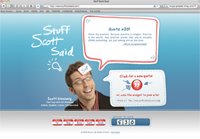 Who’s quoting YOU?
Who’s quoting YOU?
Check out Scott’s Online Quotation Database for a bite-sized education on branding success!
www.stuffscottsaid.com.
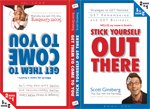 The world’s FIRST two-in-one, flip-flop book!
The world’s FIRST two-in-one, flip-flop book!
 I don’t do drugs.
I don’t do drugs.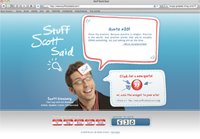 Who’s quoting YOU?
Who’s quoting YOU? If you’re not polarizing, you’re not monetizing.
If you’re not polarizing, you’re not monetizing.
 Execution isn’t a hobby.
Execution isn’t a hobby.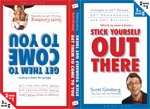 The world’s FIRST two-in-one, flip-flop book!
The world’s FIRST two-in-one, flip-flop book! “Nothing should be called good that fails to enlarge our humanity.”
“Nothing should be called good that fails to enlarge our humanity.” Who’s quoting YOU?
Who’s quoting YOU?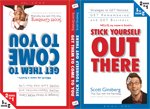 The world’s FIRST two-in-one, flip-flop book!
The world’s FIRST two-in-one, flip-flop book! Stick-to-itiveness can be learned.
Stick-to-itiveness can be learned.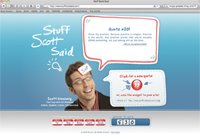 Who’s quoting YOU?
Who’s quoting YOU? Sometimes the best choice is the decision to stop choosing.
Sometimes the best choice is the decision to stop choosing. “When will you have done enough to be happy with who you are?”
“When will you have done enough to be happy with who you are?”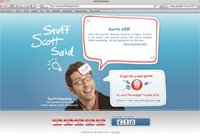 Who’s quoting YOU?
Who’s quoting YOU? Determination alone fails.
Determination alone fails. 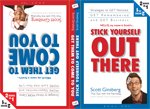 The world’s FIRST two-in-one, flip-flop book!
The world’s FIRST two-in-one, flip-flop book!